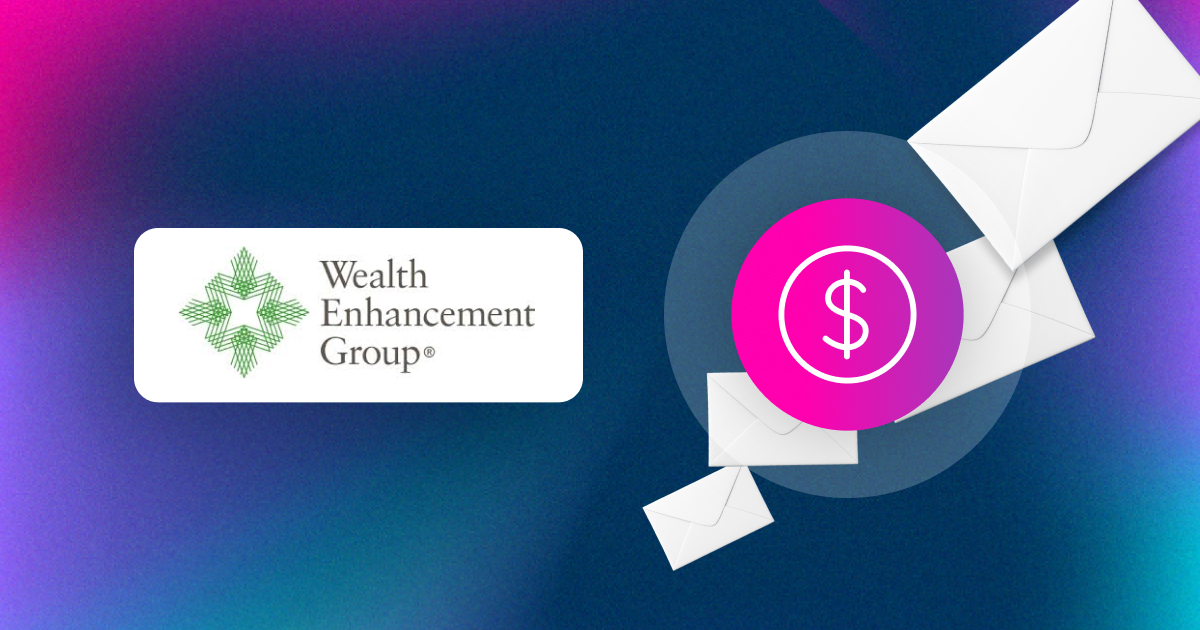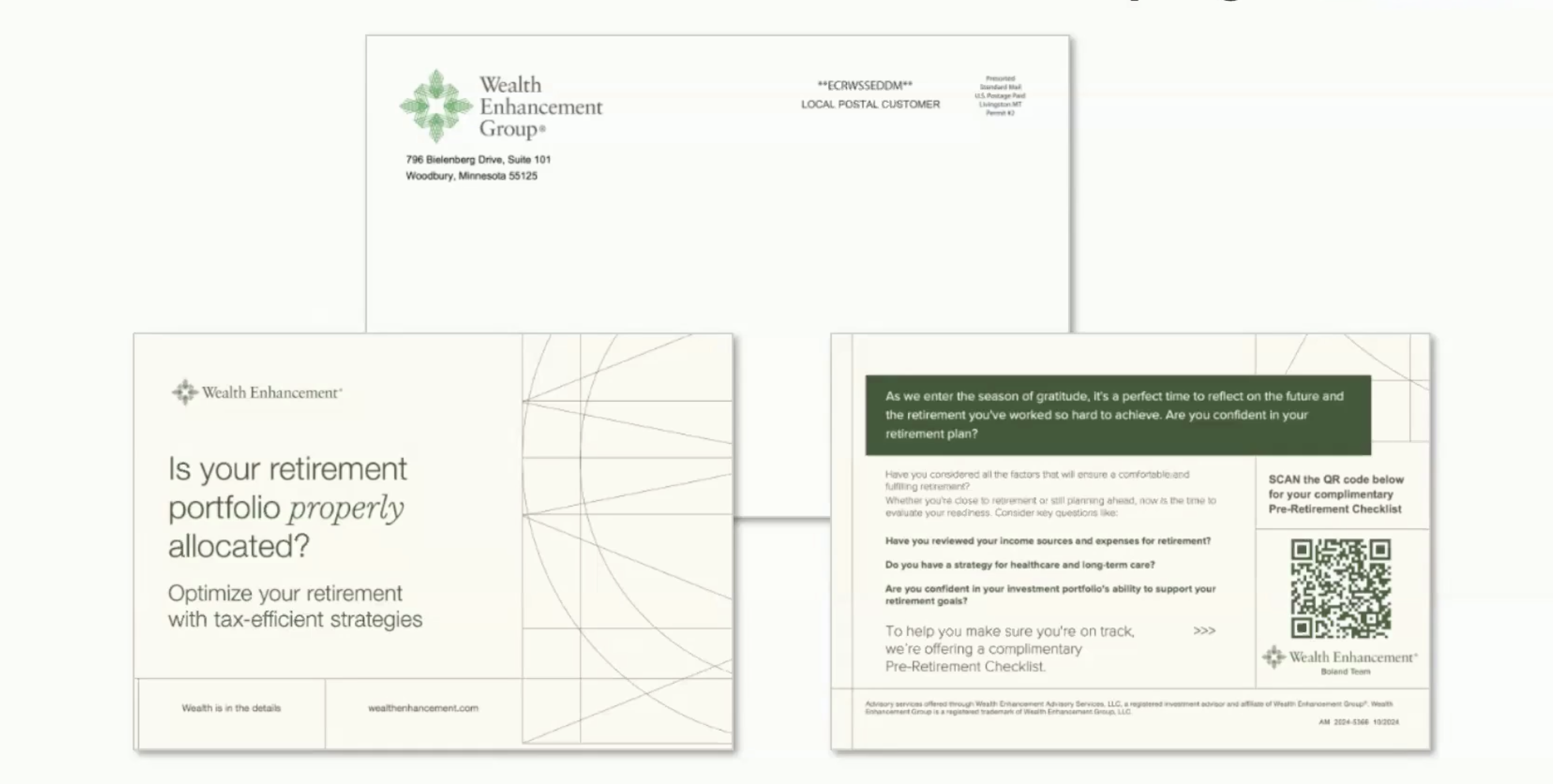
WEG Finds Direct Mail to Be ‘Secret Sauce’ For Reaching Investors

When Francisco Quinonez started exploring direct mail campaigns for Wealth Enhancement Group's (WEG) financial advisors, he discovered something surprising: In an era dominated by digital marketing, physical mail was becoming their secret sauce for reaching high-net-worth investors.
During a recent virtual event hosted by PFL's CMO Jennifer Bellin, Quinonez pulled back the curtain on how modern financial services firms are transforming direct mail from a spray-and-pray tactic into a sophisticated, data-driven channel that complements digital strategies.
The Evolution of a Regional Marketing Powerhouse
As Senior Regional Marketing Specialist at Wealth Enhancement Group, Quinonez oversees marketing strategies for more than 40 financial advisors across the Midwest. His journey into direct mail began with a simple observation: while WEG's corporate team was seeing impressive results from mail campaigns, regional teams were missing out on this opportunity.
The motivation was clear. WEG's primary goal—increasing assets under management—requires reaching affluent investors who often ignore digital noise but still value tangible, personalized communications. For investors 55 and older with significant assets, a well-crafted mail piece commands attention in ways email simply cannot.

Beyond the Spray-and-Pray Approach
What sets modern direct mail apart is precision targeting. Quinonez revealed how his teams leverage Every Door Direct Mail (EDDM)—not just for bulk distribution, but as a sophisticated research tool. By analyzing demographic data at the postal-route level, they uncover pockets of high-net-worth households that traditional targeting might miss.
"We discovered affluent neighborhoods we didn't even know existed," Quinonez noted, explaining how granular ZIP code analysis revealed untapped markets within existing territories.
But the real innovation lies in personalization. Teams targeting specific employers or professional groups craft messages that speak directly to those audiences' unique financial planning needs. A campaign aimed at healthcare professionals, for instance, addresses retirement planning challenges specific to medical practices.
The Digital-Physical Integration Playbook
Perhaps the most compelling aspect of WEG's approach is how seamlessly direct mail integrates with digital channels. Every campaign includes trackable elements—QR codes, dedicated phone numbers, and unique URLs—that bridge the physical and digital divide.
Quinonez shared WEG’s webinar promotion strategy: A simple postcard drives recipients to scan a QR code for registration, automatically capturing engagement data. Their pre-retirement checklist campaign takes this further, offering valuable content in exchange for contact information, nurturing prospects through automated digital follow-up.
One surprising finding: For client-appreciation events, direct mail invitations generated response rates matching email invitations—debunking the myth that digital always outperforms physical channels.

Campaign Architecture That Delivers Results
Quinonez shared several campaign blueprints that consistently drive results:
The Multi-Touch Tax Planning Campaign: Features advisor photos for personal connection; combines QR codes for guide downloads with tracked phone numbers; and enables precise ROI measurement through call tracking.
The High-Value Prospect Outreach: Uses purchased lists to identify affluent 55-plus prospects; delivers substantial mail pieces in branded envelopes; and triggers systematic follow-up calls from client teams.
The Content-First Approach: Offers genuinely useful resources (checklists, guides, assessments); captures prospect information through value exchange; and nurtures leads through integrated digital campaigns.
Building the Business Case
For Quinonez, tracking isn't just about measuring success—it's about building internal buy-in for expanded programs. By meticulously tracking QR code scans, phone calls, meeting bookings, and eventual client acquisitions, he creates compelling ROI stories that secure continued investment.
"When you can show that a $2,000 mail campaign generated 15 qualified meetings and three new clients worth $2 million in assets, the conversation about budget becomes much easier," he explained.

The Format Evolution
WEG's journey also reveals important insights about format preferences. While they started with simple postcards, Quinonez found that substantial mailings in envelopes—including team bios, fold-out pieces, or multiple inserts—generate significantly better response rates.
The psychology is straightforward: An envelope with weight and substance signals importance, demanding attention rather than immediate disposal. This finding aligns with broader industry research showing that dimensional mail outperforms flat mail by 300 percent or more.
The Path Forward: From Transactional to Transformational
Currently operating at what Bellin describes as the "transactional" stage of direct mail maturity, WEG executes effective one-off campaigns but hasn't yet achieved full automation or integration. The next frontier involves triggered mailings based on client behaviors, automated follow-up sequences, and deeper CRM integration.
Quinonez's upcoming experiments focus on driving attendance to in-person events—traditionally direct mail's sweet spot—while continuing to refine digital integration strategies.
Lessons for Modern Marketers
The WEG experience offers valuable insights for any organization considering direct mail:
Start with crystal-clear audience definition. Generic messaging to broad audiences wastes money. Success comes from speaking directly to specific segments' needs.
Make measurement non-negotiable. Every campaign needs trackable elements that prove ROI and inform optimization.
Think beyond the mailbox. Direct mail should spark multi-channel journeys, not exist in isolation.
Invest in quality over quantity. A smaller, targeted campaign with substantial mail pieces outperforms mass-mailed postcards.
Find expert partners. The complexity of modern direct mail—from data management to production logistics—rewards working with specialists.
As Quinonez's results demonstrate, direct mail isn't a relic of marketing's past—it's an evolving channel that, when executed strategically, delivers measurable results in our digital-forward world. For financial services firms seeking to cut through the digital din and connect with high-value prospects, the mailbox might just be their most underutilized asset.



